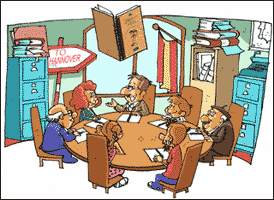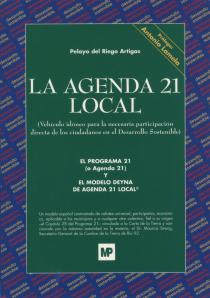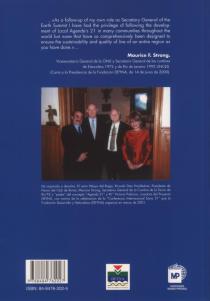Book orders: Pedidos a Ediciones Paraninfo S.A
Avenida Filipinas, 50
28003 Madrid
Tno. 91 4456218/ 91 3308915
E-mail: info@paraninfo.es
(PROJECT NUMBER 21 OF DEYNA
GENERAL PROJECT AND SIMULTANEOUSLY FEEDBACK OF THE IMPLEMENTATION OF
THE THREE-PRONGED STRATEGY)
DEYNA made a Guide or field note-book
to produce the Agendas in 1995 and published it in 1997. This guide has
been given out to the 183 municipalities of Soria and has been
extensively divulged outside this region. It was presented by the EEB
of Brussel at the ICLEI Conference of Stockholm (1997) and is today in
the hands of UNESCO, the Worldwatch Institute of Washington, PNUMA, the
Spanish Universities and Ministries.
In april 2004, DEYNA publishes the
book "The Local Agenda 21". You'll find more information about the book
at the end of this page.

Click on the image to zoom
The Deyna
Model of the Local Agenda 21 is the starting point and guiding
line of the project. Our Agenda model has been carried out under the
guidance of the local authorities and with the participation of the
social groups that constitute the municipalities, that is, "from below
to above", in a participative democracy, with the aim of achieving each
municipality's desired goals. The model is simple, short, comparable
and easy to divulge.
Once the Agendas have been carried
out, the municipalities have a program of sustainable socio-economic
action at their disposal.
DEYNA is focussing on the realization
of the "Local Agendas 21" in the region of Soria, which has turned the
province of Soria into the territory where most municipalities have
implemented the "Local Agendas 21".
As for its extrapolation, it is
already turning into a fact.
 |
Click on the image to zoom |
Gloss
on the "Deyna Model of the Local Agenda 21"
The "DEYNA Model of the Local Agenda
21" answers the requirements of the "Program 21" of the UNO, and has
been endowed with a procedure that did not appear in said programm.
Therefore, it is nowadays a basic and vertebral instrument for
stimulating the Sustainable Development, as the "Local Agendas 21" are
the starting point and guiding line to achieve it. The "Program 21",
because of its complexity and lack of an adequate vehicle ("Deyna Model
of the Local Agenda 21"), has only penetrated the administrative
technical levels (from above to below) and has not reached, up to now,
its true addressees, the individual and the small local associations,
which is the only arousing and efective action towards Sustainable
Development, and the change of consumer habits and attitudes at all
levels.
The "Deyna Model of the Local Agenda
21" can be easily processed to reach local, regional and provincial
conclusions, in a word, by means of the "Deyna model", it becomes
possible for the "Program 21" to get based on a new awareness ("from
below to above") that tends in the same direction as the administrative
actions ("from above to below"), avoiding imposed or supposed wills and
opening the possibility for the "Program 21" - which it has not had
until now - of being assimilated by all social levels, the only way of
achieving a sustainable socio-economic development.
 |
| A new institution has been
created, called the "Local Agenda 21 Committee" |
If we begin to deal with the serious
problems of humankind from the awareness of equity, of knowledge and
from a change of habits in the use of resources, it means leading the
steps of this planet's societies in the right direction and setting the
fundaments for finding a definitive solution to the greatest problem of
humankind, which is poverty.
Following the elaboration of the
Agendas, the created "Commissions for the Local Agenda 21" and the town
councils will have the possibility of getting support and advice from
the Foundation for Development and Nature (DEYNA), to sustainably
realize the mentioned objectives and others derived from these same
objectives, so that the whole province can coherently and harmoniously
progress towards the common goal of Sustainable Development.
The
book "The Local Agenda 21"

|

|
Frontpage and
backpage of the book.
Author: Pelayo del Riego Artigas
Incluing preface by Antonio Lamela
|
The book "The Local Agenda 21"
was published by DEYNA on april 2004, and can be acquired from:
EDICIONES MUNDI-PRENSA
C/Castelló, 37 - 28001 Madrid (Spain)
Teléf: +34 91 4363700
Fax: +34 91 5753998
e-mail: libreria@mundiprensa.es
Reflections
on Local Agenda 21
Right away we offer some thoughts on:
- The Local Agenda 21
instituted by Program 21
(and developed by consensus at the Rio 92 conference by 179 countries,
including Spain)
- How it is being implemented
as Local Agenda 21
- The DEYNA model of Local
Agenda 21
1. Local
Agenda 21 has become identified with the execution of a costly
environmental audit (and diagnosis) as a substantial preliminary,
indispensable, and inherent condition. The authors of Program 21, who
know what environmental audits are and have not overlooked them,
prescribe them in Chapter 30 for industrial companies. This is the only
instance in which audits are referred to in the 700 pages of Program
21. Audits are not even mentioned in Chapter 28, where Local Agenda 21
is instituted.
2. According to Chapter 28 of Program 21, by 1996,
only four years later, most of the local Agendas 21 should have been
implemented (in more than 500,000 municipalities of the planet). Would
this time limit have been established if the authors of Program 21 had
been thinking of environmental audits or diagnoses? The outcome of this
very expensive approach is that after 11 years fewer than 7000 Local
Agendas 21 have been developed in the world, 65% of them in Europe. Is
this logical? Are Local Agendas 21 intended only for rich
municipalities while the poor remain on the sidelines? At the current
rate of 700 a year, it will take 1500 years (15 centuries) to develop
the one million local Agendas 21 that are still pending.
3. Chapter 28 of Program 21 prescribes only direct,
real, and effective participation by citizens (and insists repeatedly
on the participation of women, young people, indigenous populations,
and even children). And it adds … "by holding consultations and
promoting consensus, local authorities receive the input of citizens."
Is this feasible by means of surveys, polls, or brief forums that
usually are a simulacrum of participation, or more likely to occur with
real, direct, and effective participation as proposed in Program 21 and
the DEYNA model?
4. The most suitable vehicle and, in fact, the only
vehicle designed to secure the indispensable involvement of the
community in sustainable development is Local Agenda 21. If the
citizens of each town do not really practice this, it will not serve
any purpose at all if sustainable development is promoted with slogans. This is the specific and
special "trickle-up" action prescribed by Program 21. The other actions
prescribed by Program 21, agendas and strategies, are almost all, if
not all, "trickle-down" proposals (from states, governments,
administrations, technicians, and scientists).
5. Program
21 is a program for "change" and change is difficult, it awakens
resistance and it requires sacrifice and breaking habits that are well
rooted and have a long tradition. Such a change is only possible if the
six billion inhabitants of the Planet, or as many of them as possible,
develop a strong and serious awareness of the need for change. This
awareness can only arise from real and effective citizen participation,
as understood by Program 21 and repeated again and again. Marketing
methods are unsuitable since they are usually designed to stimulate an
increase or improvement, not a decrease, or, much less, difficult and
radical changes.
6. Local Agenda 21 has been confused with
environmental quality standards (ISO, EMAS) for no justifiable reason.
Environmental quality standards have their own field of action and
scope of application, to which we have no objection, as is logical.
Local Agenda 21 is socioeconomic plan that is sustainable and linked to
the intergenerational solidarity agreed upon by citizens and local
authorities for the good of each town, it's that simple. It is not
something that is strictly confined to the "environment" or "urban
environmental quality" and does not require the necessary intervention
of technical specialists, as is usually understood. Some Local Agendas
21 that are cited as examples are urban plans and controlled
demolitions designed to improve the quality of tourism, which has
little to do with their nominal designation. While undoubtedly
legitimate and positive actions, there is no reason to call them Local
Agendas 21, which confuses the target audiences of Agendas 21.
7. The Aalborg Charter (Denmark) was signed on 17 May 1994 in the
Danish city of Aalborg by local European leaders attending the European
Conference of Sustainable Cities and Towns. This conference was
sponsored by the "International Council for Local Environmental
Initiatives" (ICLEI), an organization that appeared in 1990 at the
World Congress of Local Governments for a Sustainable Future, which has
propitiated the development of the European concept of local Agendas 21
of audits and diagnoses.
However, the fact that local authorities take refuge behind the concept
of the European city where the document was signed does not achieve any
convincing appearance of substantial citizen participation, as
prescribed by Chapter 28 of Program 21, which is the document that
instituted the local Agenda 21. The concept of town counts for nothing,
while that of the city carried some weight (in itself untenable by
definition), and the consensus cited is none other than that which is
reached or can be reached by political groups. In the original document
in English, Program 21 isn't cited, although Agenda 21 is. This
undoubtedly loosens the link because Program 21 is still published by
the UN under the name of Program 21, although it is known colloquially
as Global Agenda 21 or just Agenda 21. The universality of the actions
does not seem to be a concern. The self-complacency of Europeans with
their indicators (Europe occupies only 6.6% of the surface of the
planet and has 12% of the world population) does not contribute to any
significant solution, given the atmospheric, marine, and other
"rebound" effects. The indicators published by the UNEP (GEO = "Global
Environmental Outlooks") are planetary and are recorded in more than
one hundred observatories. In our opinion, the behavior of 88% of the
worldwide population occupying 93.4% of the land surface is more
relevant for the well-being of the Planet. Europe should offer
solutions and good, universally applicable examples, no matter how
"simple" these may seem, instead of celebrating their own excellence
and exclusivity.
Local leaders, a common concept in development, turn it into a
corporative document and clearly have a prominent role in the other
modalities of Agendas 21 (national, autonomic, administrative,
provincial, etc), as well as in the noble effort to develop plans for
excellence, environmental management, audit-proof quality, diagnoses,
etc. However, the role of local leaders in Local Agenda 21 is to summon
the citizens of towns to engage in a dialogue and agree upon a local
action plan, as prescribed by Program 21. Local Agenda 21 is special,
inescapable, and must be implanted, as few other programs must be, in
more than 1,000,000 municipalities or similar territories throughout
the Planet. These programs must be truly popular, as was so presciently
foreseen by Program 21, because this is the only population segment (no
less than the vast majority of the 6,000,000,000 inhabitants of the
world) that has not yet become integrated and directly implicated in
sustainable development. If this population segment does not
consciously become involved in the task, there will never be
sustainable development.
The result is that participation is relegated to a testimonial forum as
a way of completing a necessary transaction, culminating finally in
surveys and opinion polls. The Letter to the Earth, a truly
participatory document, is a decalogue of sustainable development of
universal validity that deserves to be more widely known and practiced.
Read it and its prescriptions and compare them with those of other
documents. The DEYNA model of Agenda 21 adheres closely to this Letter
to the Earth and more than 200 Spanish city councils have endorsed it
because of the divulgation it received in 2002 by DEYNA, in
collaboration with the Biodiversity Foundation, which submitted it to
8104 city councils in Spain. The Declaration of Cork of the EU in 1996
also proclaimed the importance of participation for Sustainable
Development.
8. The cost of implementing a Local Agenda 21 cannot
be a hindrance. Of out of 1,000,000 of municipalities of the world, the
overwhelming great majority do not have resources but they do have
citizens, natives, women, and young people. All of them are capable of
dialoguing and politicians can make the effort to reflect on their
input and decide what should be done, set goals, and to build
awareness. To do so they require only elemental information and
motivation to initiate the process, which is simple and brief.
9. The Local Agenda 21 of each municipality can
feasibly reach the awareness-raising goal of making its objectives
known, in writing or verbally, to each citizen. Is this possible with
the compendia of data generated by the usual Local Agenda 21, which few
people read? These data are already known and found in government
archives and usually contribute to a stew of cryptic methodologies,
complex Anglicisms and graphs, DAFO analyses, ratios, equations, and
other products typical of business and postgraduate schools, as well as
indicators (the life's blood of statisticians and administrative
organizations, which are highly specialized and organized no lower than
at the provincial level). This tends to cloak actions (possibly in
relation to Program 5 of the EU and the resources of LEADER and PRODER
programs) that are condemned to vegetate in city councils. A brief
consensus document briefly stating the goals of the municipality in the
coming years and signed by participants, who are known to the
inhabitants of each municipality, produces awareness, willingness, and
a critical mass that can mobilize the community towards Sustainable
Development in every town in the world in short time, which is the only
time we have.
10. Local Agenda 21 is not something that is done so
that politicians can conclude that "we
have met this obligation or requirement so that we can be considered
very modern and knowledgeable..." or a commercial product that
is offered to local authorities who are uninformed about the subject: "Let us prepare your Agenda 21." The
inhabitants of the town and their authorities must do this together; it
should be something alive and in continuous evolution and renovation in
the future and it should generate a new attitude among citizens and
authorities.
11. A simple, brief, universal, and concise model
makes it possible not only to raise awareness and promote collective
responsibility, which is the primordial objective of Program 21, but
also to obtain information and codifiable and processable data of
interest to public authorities.
12. Therefore, actions in the field of sustainable
development between administrations and those administered by them
(national, autonomic, and provincial agendas or strategies, and the
very specific local Agendas 21) should be convergent, harmonious, easy,
and transparent in order to close the circle between idea and action.
The necessary participation can be secured if a serious proposal is
made, not a pretence. Opinion surveys, which bind no one and are
completed anonymously, are not very effective for the matter at hand.
13. Participation and consensus legitimize actions
that are beneficial to the community but, because of their difficult or
impossible political capitalization, cannot conceivably be implemented
any other way.
14. Program 21, originally 700 pages long, is widely
unknown and is now an expensive book that is difficult to obtain,
although, as the treaty for Sustainable Development, it is hard to find
anything similar or better. It should be made available to all
provincial and local authorities, and to all acting groups (companies,
unions, NGOs, associations, and others) so that they can take note of
its prescriptions, which should be taught in training centers, and its
contents, which should be discussed and analyzed by citizens. There has
been no interest in its divulgation. We do not know why.
15. The DEYNA model of Local Agenda 21®,
developed in 1995, is an original Spanish model that can be applied
universally. It is the product of years of study, background work, and
creative effort by its authors, members of the Spanish Chapter of the
Club of Rome. It was awarded a gold medal in the Program of
International Projects at the Hannover EXPO 2000 and has received the
praise, ratification, and recognition of the author of the Agenda 21
concept, the leading world authority in the material and father and
Secretary General of the Earth Summit, Dr. Maurice Strong. This is an
excellent program that is easy to implant and has been used by 113
municipalities of Spain, in towns of the provinces of Leon and
Cáceres. It merits consideration, and its practice and
divulgation should be promoted, since it offers a concept and rigorous
methodology that are absolutely faithful to Chapter 28 of Program 21,
applicable to towns and any other entity or collective group in which
people must acquire information and weigh its implantation in any
territory of the planet.

|







